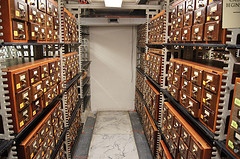As books move from print to digital, there’s been much hand-wringing about the impact this shift will have on libraries. Add to the already pressing budgetary woes, new challenges: Some publishers have been recalcitrant in making their catalogs available for digital loans. Other have tried to institute more restrictive lending policies, most infamously in the case of Harper Collins, by saying that e-books could only be checked out 26 times before libraries would need to purchase another license.
Then there are the series of lawsuits aimed at various digitization efforts: suits against theGoogle Books project and against the HATHI Trust.
Yet at the same time as the way forward for libraries seems clouded by powerful forces trying to lock down or knock offline digital content, the very culture behind the library and the archive seems to be stronger and more innovative than ever. Indeed, if I look around at some of the most exciting projects in technology right now, they’re ones that are thinking through some of the thorny problems of preservation (digital and otherwise), discoverability, accessibility, interoperability, copyright and licensing, open source, open data, and metadata. They’re the projects of librarians, archivists, digital humanists, and scholar-hackers.
Many of these folks are gathered in Washington DC today for the plenary meeting of the Digital Public Library of America (or are participating via the Twitter hashtag #dpla)

It’s sometimes felt lately that elements of the publishing and consumer electronics worlds have wanted to hit a big “reset” button on that great American project of Andrew Carnegie: the public library. So it’s somewhat reassuring to hear Peter Baldwin, chair of the Arcadia Fund, say “What Carnegie did for public libraries a century ago, the DPLA could—if successful—accomplish for our era.” The Arcadia Fund, along with the Sloan Foundation, announced $5 million funding today to help the initiative move forward. And Europeana, the EU’s cultural heritage Web portal, also announced their collaboration and promised interoperability between the sites.
Even if the DPLA is to follow the path that Europeana has taken (and it is a good model in many ways), the creation of the DPLA will be no easy task.
After all, there’s not a clear agreement yet on what exactly the DPLA will be. Is it a public library? Is it an academic library? Is it a research library? (Or all of the above.) Is it an online repository? Will there be “check-outs”? Is it a separate institution? Is there a physical building? Is it a website? Is it a portal?
What do we want from a digital public library? Who gets a say in that? (To answer that question, in part, you can see the membership of the DPLA steering committee here.) What will it look like? What will it do?
To get a sense of the latter, you can check out the 40 projects that were chosen as finalists as part of the DPLA Beta Sprint. These projects all address some of the things I note above: open source infrastructure, accessibility and discoverability, interoperability, sharing and remixing resources, a new UI for a new library.
As Carl Malamud, founder of Public.Resource.Org said today at the DPLA Plenary Meeting (PDF) — remarks which are definitely worth quoting at length:
We need a decade-long commitment to scanning, we need our federal government to understand that it must deploy the Internet corps of engineers, to scan at scale, to become a much more serious contributor to that reservoir of knowledge, to be at the center of that public park that makes access to knowledge a right for all Americans, not a privilege for the 1 percent.
If a self-appointed librarian in an abandoned church like Brewster Kahle can publish 3 million books, how can our federal government not do more?
If Google can scan 10 million books just to feed its search engine, why can’t the federal government do the same to transform our nation’s educational system?
If WestLaw can scan the opinions of our courts and the statutes of our legislatures to maximize shareholder value, why can’t the Judicial Conference of the United States and our nation’s law schools work together to maximize democratic values?
If we can put a man on the moon, why can’t we launch the Library of Congress into cyberspace?
If billions of dollars can be spent to buy access to politicians, why can’t we spend billions of dollars to buy access to knowledge and justice, to promote the useful arts and commerce and science?
That is the challenge that we face, these are the kinds of bridges and reservoirs we can build, the kinds of public works projects that can become the foundation of a Digital Public Library of America, the opportunity we can realize, but only if we work together.
Image credits: Library of Congress, by Flickr user Matt Riggott
You need to be a member of School Leadership 2.0 to add comments!
Join School Leadership 2.0